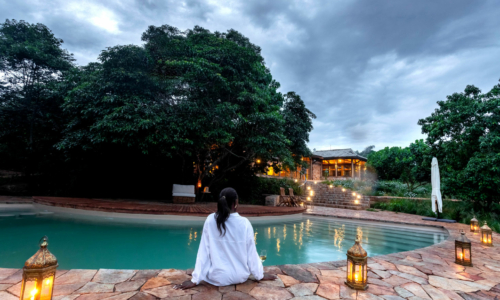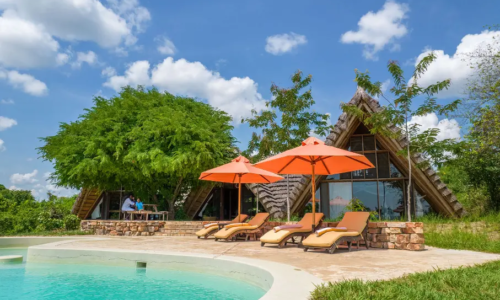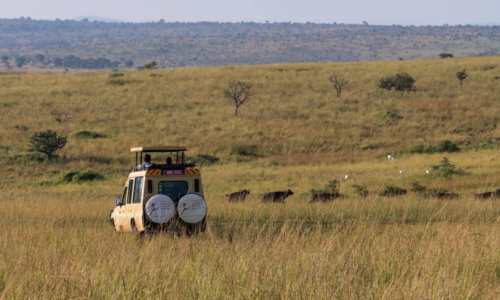The Bwindi Impenetrable National Park was established in 1992 and recognized as a World Heritage Site in 1994. Bwindi actually means impenetrable in the local Rukiga language. It’s appropriately named as it encompasses 203 miles of tangled vegetation draped over a deeply fissured landscape of steep, slippery valleys, and high, windy ridges. Despite the challenging terrain, it is well worth the effort. It is an ancient rainforest, the ideal habitat for the endangered mountain gorilla. Bwindi has seven habituated gorilla groups that are tracked by tourists. Three of these are in the vicinity of Buhoma and one at Nkuringo.
The mountain gorillas are up to three times the size of the average man and males can weigh around 430 pounds. A fully erect males may reach six foot three inches in height with an arm span of eight feet six inches long. Their thick fur enables them to live in colder climates like Bwindi which can be quite cold in the mornings and evenings. Adult males are called silverbacks because a saddle of gray or silver-colored hair develops on their backs with age. They primarily stay on the ground unless a tempting fruit tree can bear their weight. In addition, they are diurnal and most active between six a.m. and six p.m.
Gorilla tracking tours take visitors into the forest for an hour-long encounter with the gorillas which is about as much time as these noble creatures can endure. To limit their exposure to both human disturbances as well as diseases, only a maximum of eight people can visit the gorillas at a time. It is very important for both the gorilla’s safety as well as the human’s that guests follow their guide’s rules at all times. A seven-meter distance much be kept at all times to keep the primates comfortable. Quiet voices and no flash photography ensure they don’t become startled. After all this is their home and should be treated with respect. Which is why all trash must be disposed of elsewhere. Most importantly, never ever touch the gorillas! It’s also crucial to remember not to visit the gorillas if sick, these primates, an evolutionary cousin of humans, are highly susceptible to human diseases.
Those embarking on a gorilla tracking expedition should remember to prepare accordingly. Good hiking shoes that can traverse muddy terrain are vital to success. Because there are two concentrated wet seasons, short rains in March-May and heavy rains in September-November with long hours of soft drizzle, adventurers should bring rain gear as well as sunscreen, a hat, and insect repellent. Pack a lunch and bring plenty of water but remember to take the trash back to the hotel. Of course, a camera minus the flash is an essential for capturing that once in a lifetime moment of watching these majestic primates in their forest home.


- Apoka Safari Lodge
- Baker’s Lodge
- Bwindi Lodge
- Chameleon Hill Lodge
- Clouds Mountain Gorilla Lodge
- Gorilla Forest Camp
- Honey Bear Bush Camp
- Ishasha Wilderness Camp
- Kibale Lodge
- Kyambura Gorge Lodge
- Mahogany Springs Lodge
- Mihingo Lodge
- Mount Gahinga Lodge
- Mweya Safari Lodge
- Ndali Lodge
- Nile Safari Lodge
- Papa’s Camp
- Primate Lodge Kibale
Coming soon!
- Apoka Safari Lodge
- Baker’s Lodge
- Bwindi Lodge
- Chameleon Hill Lodge
- Clouds Mountain Gorilla Lodge
- Gorilla Forest Camp
- Honey Bear Bush Camp
- Ishasha Wilderness Camp
- Kibale Lodge
- Kyambura Gorge Lodge
- Mahogany Springs Lodge
- Mihingo Lodge
- Mount Gahinga Lodge
- Mweya Safari Lodge
- Ndali Lodge
- Nile Safari Lodge
- Papa’s Camp
- Primate Lodge Kibale
Coming soon!

The Bwindi Impenetrable National Park was established in 1992 and recognized as a World Heritage Site in 1994. Bwindi actually means impenetrable in the local Rukiga language. It’s appropriately named as it encompasses 203 miles of tangled vegetation draped over a deeply fissured landscape of steep, slippery valleys, and high, windy ridges. Despite the challenging terrain, it is well worth the effort. It is an ancient rainforest, the ideal habitat for the endangered mountain gorilla. Bwindi has seven habituated gorilla groups that are tracked by tourists. Three of these are in the vicinity of Buhoma and one at Nkuringo.
The mountain gorillas are up to three times the size of the average man and males can weigh around 430 pounds. A fully erect males may reach six foot three inches in height with an arm span of eight feet six inches long. Their thick fur enables them to live in colder climates like Bwindi which can be quite cold in the mornings and evenings. Adult males are called silverbacks because a saddle of gray or silver-colored hair develops on their backs with age. They primarily stay on the ground unless a tempting fruit tree can bear their weight. In addition, they are diurnal and most active between six a.m. and six p.m.
Gorilla tracking tours take visitors into the forest for an hour-long encounter with the gorillas which is about as much time as these noble creatures can endure. To limit their exposure to both human disturbances as well as diseases, only a maximum of eight people can visit the gorillas at a time. It is very important for both the gorilla’s safety as well as the human’s that guests follow their guide’s rules at all times. A seven-meter distance much be kept at all times to keep the primates comfortable. Quiet voices and no flash photography ensure they don’t become startled. After all this is their home and should be treated with respect. Which is why all trash must be disposed of elsewhere. Most importantly, never ever touch the gorillas! It’s also crucial to remember not to visit the gorillas if sick, these primates, an evolutionary cousin of humans, are highly susceptible to human diseases.
Those embarking on a gorilla tracking expedition should remember to prepare accordingly. Good hiking shoes that can traverse muddy terrain are vital to success. Because there are two concentrated wet seasons, short rains in March-May and heavy rains in September-November with long hours of soft drizzle, adventurers should bring rain gear as well as sunscreen, a hat, and insect repellent. Pack a lunch and bring plenty of water but remember to take the trash back to the hotel. Of course, a camera minus the flash is an essential for capturing that once in a lifetime moment of watching these majestic primates in their forest home.

- Apoka Safari Lodge
- Baker’s Lodge
- Bwindi Lodge
- Chameleon Hill Lodge
- Clouds Mountain Gorilla Lodge
- Gorilla Forest Camp
- Honey Bear Bush Camp
- Ishasha Wilderness Camp
- Kibale Lodge
- Kyambura Gorge Lodge
- Mahogany Springs Lodge
- Mihingo Lodge
- Mount Gahinga Lodge
- Mweya Safari Lodge
- Ndali Lodge
- Nile Safari Lodge
- Papa’s Camp
- Primate Lodge Kibale
Coming soon!
- Apoka Safari Lodge
- Baker’s Lodge
- Bwindi Lodge
- Chameleon Hill Lodge
- Clouds Mountain Gorilla Lodge
- Gorilla Forest Camp
- Honey Bear Bush Camp
- Ishasha Wilderness Camp
- Kibale Lodge
- Kyambura Gorge Lodge
- Mahogany Springs Lodge
- Mihingo Lodge
- Mount Gahinga Lodge
- Mweya Safari Lodge
- Ndali Lodge
- Nile Safari Lodge
- Papa’s Camp
- Primate Lodge Kibale
Coming soon!






 Safari Camps
Safari Camps Points of Interest
Points of Interest Hotels & Resorts
Hotels & Resorts  Journeys
Journeys
































